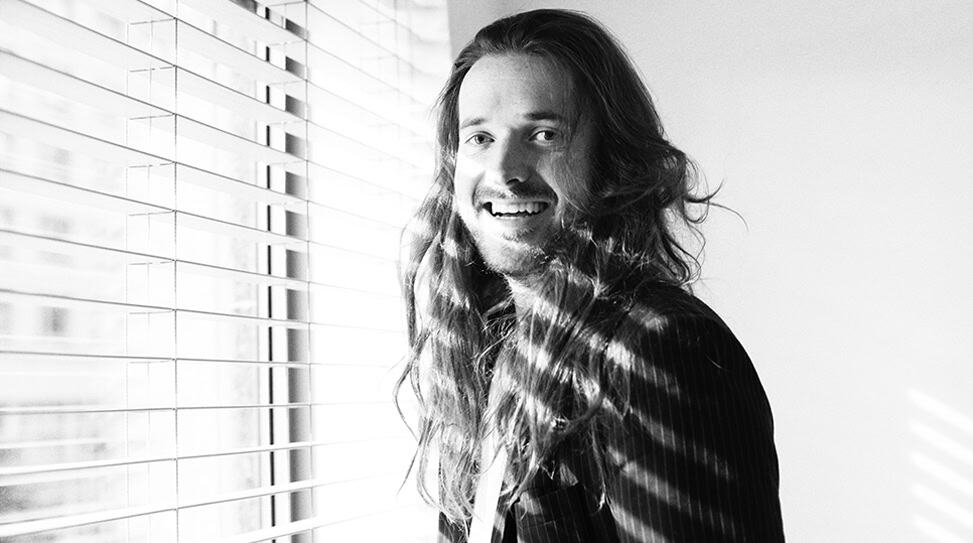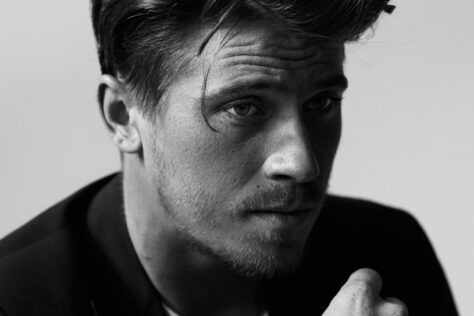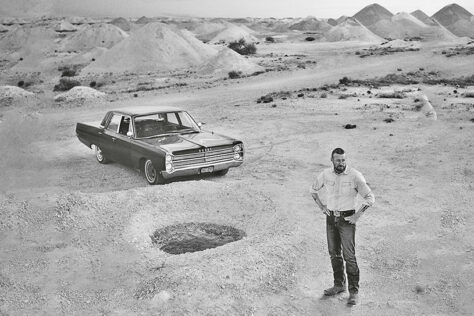Discovering montage without someone telling me how to do it felt like I discovered the vaccine to polio—a six-year-old's version of it.
In I Origins, Ian Gray (Michael Pitt) is a molecular biologist pursuing a PhD in eye evolution who, one night at a party, chances on Sofi (Astrid Bergès-Frisbey), a mysterious girl with striking eyes who he asks to photograph. In a burst of inexplicable connection, they make love, but when Ian makes a mistake in asking, “You’re not going to regret this in the morning, right?” she bolts without a whisper. The universe offering a seemingly predestined series of coincidences, Ian reunites with Sofi only to discover they are polar opposites: Sofi, an intuitive and spiritual soul, whose openness to the possibility of past lives and the existence of the afterlife, runs up against Ian’s pragmatic approach to our place in the universe. Their opposites-attract-romance is intense and then ruined by tragedy, an accident so unthinkable that it destroys Ian completely—Sofi’s death is nuclear annihilation for Ian. Meanwhile, in the lab, Ian and his assistant Karen (Brit Marling) arrive at a shocking breakthrough that could unlock the key to reincarnation.
Mike Cahill’s crazy-ambitious and exploratory follow-up to Another Earth refuses to let a modest budget constrain its mind-bending premise, much like the film that came before. I Origins is an unusual story with romantic, biological and metaphysical dimensions, and as distinctive as Another Earth was, Cahill’s sophomore feature marks a quantum leap in all departments as a dense experience aspiring for something grand, universal, and deep. It often achieves that goal.
I Origins opens in select theaters July 18.
Another Earth was actually the last film I could squeeze in at Sundance before catching my flight home. That was quite the movie-going experience.
Wicked! Oh my gosh, that was the moment where I thought, “Am I living this life? Wait a second! This is ridiculous…” It was so overwhelming. It was so joyful and beautiful. And unexpected! Totally unexpected. In that moment, you’re vulnerable, maybe a little earnest. You’re trying to do something sincere. I’m so glad you were there for that!
I got chills just sitting in the audience. Numerous times, in fact.
Ah! That’s amazing, man. It’s been such a trip with I Origins, too. Where did you see it?
I actually saw this one a couple days ago at a press screening.
When we screened it inside the Eccles Theatre at Sundance, there was surround sound tears in the audience. I like watching films with an audience because it’s a cool feeling. Again, it was like, “What is going on?” I feel lucky to have met all the creative people I’ve been working with.
When did the idea for I Origins come to you? Is this a story you developed after Another Earth was over and done with?
It was way before Another Earth! Actually, strangely… You’re the first person I’m telling this. I’ve already done a few interviews and I don’t know why I didn’t think of it. I made a short film about this way long ago. It must’ve been 2003? It wasn’t called I Origins, I think it was called i. And nothing happened with it. I haven’t shown that to many people… It’s like sitting on a shelf. It was bad. It was really bad. I shouldn’t show it to anybody. [Laughs]
It can’t be that bad! Why don’t you just throw it on the I Origins DVD as a special feature?
I can’t do that. No… It’s bad. [Laughs] I mean, I guess I can do it like, “This is what bad is.” I guess it wasn’t terrible. It takes a long time to figure out how to make a movie, you know? Another Earth happened ten years after I learned how to make things. I sort of had a professional career as a documentary filmmaker. I made things for National Geographic and edited a bunch of stuff, but I was trying to figure out how to make movies the whole time. I made a bunch of short films that were OK, but after doing that, I started to figure out little tricks and methods and techniques.
I can sense that you’re driven by a lot of different curiosities. You worked at National Geographic, you’re a filmmaker asking life’s big questions, you studied economics in school, and you’re very much taken by—
Science.
Exactly. When did filmmaking become this driving force in your life?
It was such a simple thing, but when I was a kid, I had one of those Fisher Price cameras—PixelVision2000! I remember, very distinctly, filming my little brothers sitting in my mom’s car. I filmed that from the side and also filmed a Matchbox car that I pulled along with string. It was one of those cameras where you film, then stop, film, then stop. I was basically trying to make it look like they’re driving the Matchbox car. It’s such a simple concept, but to me, it felt like lightening had struck my head. I was so excited by the possibilities. I’m like seven or eight years old at this point. This was fucking awesome. This is what I wanted to do for the rest of my life. Press record, stop. Press record, stop. Discovering montage without someone telling me how to do it felt like I discovered the vaccine to polio—a six-year-old’s version of that. I did that for awhile, but then I stopped and became this young man. I played sports and did this and that. It wasn’t until I was at Georgetown studying economics where I watched three movies in one week that made me go, “This is what movies are?” I was like eighteen and I saw Sex, Lies, and Videotape by Steven Soderbergh, Basquiat by Julian Schnabel, and Three Colors: Red by Krzysztof Kieslowski in a row. I was like, “WHAT? This is not the kind of movies I see in the movie theater. What are these beautiful, powerful vessels of emotion?”
You found cinema.
I found cinema! That one week changed my entire life: “I’ll finish my study in economics, but I need to get a camera now.” I remember I was working at this pizza place and saved up $100 to buy this Super 8 camera at a pawnshop. I would use Georgetown library’s Adobe Premiere, which was analog-ish in the sense that you digitized stuff, but not with Firewire. I taught myself to edit properly just by playing with the machine and experimenting. That strangely turned into me working for National Geographic, which involved some weird set of coincidences. Eventually I wanted to make films, but it took a while. I knew I liked it as a little kid, but when I saw those movies I said, “This is what it’s all about!” The whole purpose of it is this: I find something that’s really hard to articulate. I can tell you, “I want you to have a diminished fear of death” and maybe you can connect with that, but that’s just hitting your brain. Art isn’t about hitting you there, it needs to go through your entire being viscerally. Whether it’s a painting or a song or whatever, I’m trying to give you an emotion for you to have so you can experience it. With Another Earth and with this movie, the whole thing is about building up to that final moment. You have so many things to address and deal with, but when you get to this final, precise moment, it’s magical. In Sex, Lies, and Videotape, it’s the moment when he’s with her at the end and you don’t know if they had sex or he’s no longer impotent—it’s wonderful. In Red, it’s when she gets out of the raft, and when the news channel pauses, her hair’s wet and the man with the life jacket is right behind her. All of a sudden, she’s in the exact same composition as the bubblegum commercial. Fate. Destiny right here! You’re feeling something. In Basquiat, you see him walking down the street with this little kid walking behind him and the kid disappears. I wanted to capture that kind of breathless feeling.
You entertain grand, universal ideas that make us, as humans, feel interconnected.
Yeah, totally!
But to help ground both Another Earth and I Origins in reality, there’s a lot of facts that need addressing. I wonder how much energy you put into the research, especially with the new film, when your main protagonists are scientists working in a lab.
I was really lucky because my two older brothers are both molecular biologists and they do what Ian does in the movie. I basically just stole. [Laughs] I would literally go to their labs and like chill there and listen to what they’re saying. The colorblind mice seeing color is an experiment that my brother did. Modifying mice to have vision was another experiment that they did in the lab. In terms of the Pax-6 gene, it’s the gene that all seeing species have in common. You know how they say humans and apes share the same 99.9% DNA? Well, humans and flies—flies have arthropod eyes—we share the same exact genes that turn on the eyes. This gene is like a 400-string of amino acids—Gattaca!—and it’s precisely the same in a fly’s as it is in us for Pax-6. It’s crazy and every species has this. So I wanted it all to be very authentic and realistic. There was a lot of research, but I had easy access to my research. I had this on speed dial. [Laughs] One of my brothers hung out on set when we were doing this and that allowed us to improv. Michael and Brit would spend time with him, and he’d be like, “91% identity…” I don’t remember what they said! I don’t know what any of this meant, but as long as I had a scientist watching, we could stay accurate. It’s great.
What an incredible resource to have.
It was a great resource! It was a really great resource. I want to make as many scientist friends as I can in my life and just hang out with them. I’ll have them hang out on set so we can riff.
There are already talks about a potential sequel to I Origins. Is it valid?
100% true. It’s definitely something I want to do and Fox Searchlight wants to do. The movie comes out later this month, so you tell all of your friends to see it and all of their friends to see it three times. I think it’ll happen. The thing about the sequel is that it takes place in the future—it’s going to be a bit more expensive—where everything that was discovered in I Origins is taken for granted. When a baby is born, you know exactly who they were in their past life. Now everyone has to deal with the implications of this, especially when you don’t want to be the person who you once were, and using that as a metaphor for our own suppressed pasts.
That’s an intriguing premise. I really hope you get to make it.
I hope I get to make it too! You can come visit the set.
We should also discuss your collaboration with your actors. The performances give your films a lot of emotional weight.
I’ll tell you a little secret: Work with really talented actors. Truly talented actors dig so deep into their characters that they become a huge resource for a writer-director. They, all of a sudden, know more about the character than you could ever dream of. Their input becomes vital in turning a character three-dimensional and complex. They all own their characters way more than I ever did. We talk. We rehearse a lot because I love that. I like to rehearse because you can see what doesn’t work and you go, “OK, my writing is horrible.” [Laughs] You change everything and do it constantly. You just want to constantly make it better and turn it into something that rings true. The most important things are the plotting and getting that ethereal feeling, but how do we get there? I’m open to the very organic nature of filmmaking. You might write a script and throw the whole thing away when you’re making it. You do it again and throw that whole thing away when you’re editing it. It gives me a great deal of confidence to know that, as long as we capture the fundamentals with the plotting, there’s freedom in the moment. Another thing that we were fortunate with on this film was that we shot simultaneously with two RED cameras in L-shaped angles or shot reverse shot. It was tricky for lighting sometimes, but it allowed for the actors to improvise, especially with the blocking. The actors can actually move around and we can cut it together very seamlessly when you’re shooting with two cameras. You can honor the spontaneity of the performances, which is wonderful.
You also edit everything yourself. Is that a comfort to you? Are you editing in your head as you go along?
Sometimes I do it literally. There are some scenes that I shoot that I want to cut over a weekend just to make sure they’re working. I was showing Michael some of the movie as we were going along and it’s fun. But when we’re shooting, I’m definitely cutting it in my brain, which gives me a great deal of confidence again. It’s my little safety net. Editing is how you close the deal. You’re the last person to touch it before it’s in the world, aside from color and sound. No, it’s very important to me because then you don’t have to worry too much about where you’re putting the camera. Even in the moment, you can be adventurous as a filmmaker, as long as you know where it’s going to end up later. I shoot a lot of masters from beginning to end. I let the actors go from the beginning of a scene all the way to the end in a wide shot so they can maintain a rhythm. Very rarely do I want to go from take three to take seven in an edit. I like it to all be from take three with the footage from both cameras, if possible. It’s nice to keep it consistent because the work actors do is so nuanced. I want to honor and respect that work.
I just want to take you down memory lane for a second, and it has to do with your beautiful locks. We were talking to Cameron [from Fox Searchlight] earlier and he brought up a red carpet story where they asked you about your hair routine?
Oh my gosh! [Pause] Yes, I do remember this one interview turning into a hair commercial… It wasn’t necessarily Cameron’s job to look after me, but he became a publicist in that moment. They were like, “What kind of hair preparation do you do? What products do you use?” I was like, “Uhh… Pantene? Head & Shoulders?” [Laughs]

 Clarion Call: Garrett Hedlund
Clarion Call: Garrett Hedlund A Conversation with Simon Baker
A Conversation with Simon Baker
No Comments